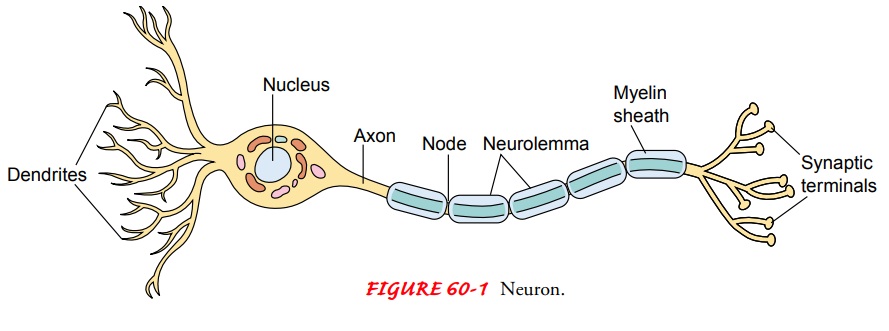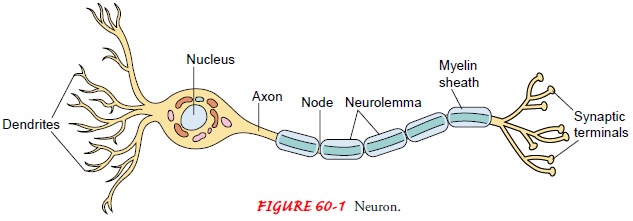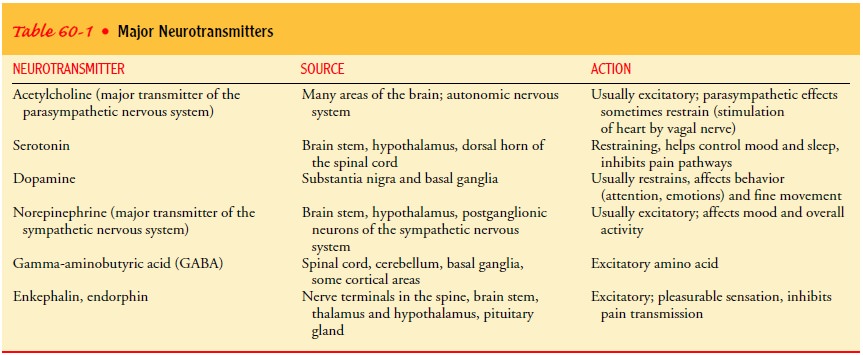Chapter: Medical Surgical Nursing: Assessment of Neurologic Function
Anatomy of Cells of the Nervous System, Neurotransmitters

ANATOMY OF THE NERVOUS SYSTEM
Cells of the Nervous System
The
basic functional unit of the brain is the neuron (Fig. 60-1). It is composed of
a cell body, a dendrite, and an axon. The den-drite
is a branch-type structure with synapses for receiving elec-trochemical
messages. The axon is a long
projection that carries impulses away from the cell body. Nerve cell bodies
occurring in clusters are called ganglia or nuclei. A cluster of cell bodies
with the same function is called a center (eg, the respiratory center).
Neuroglial cells, another type of nerve cell, support, protect, and nourish
neurons.

Neurotransmitters
Neurotransmitters
communicate messages from one neuron to another or from a neuron to a specific
target tissue. Neurotrans-mitters are manufactured and stored in synaptic
vesicles. They enable conduction of impulses across the synaptic cleft. The
neuro-transmitter has an affinity for specific receptors in the post-synaptic
bulb. When released, the neurotransmitter crosses the synaptic cleft and binds
to receptors in the postsynaptic cell mem-brane. The action of a
neurotransmitter is to potentiate, termi-nate, or modulate a specific action
and can either excite or inhibit the target cell’s activity. There are usually
multiple neurotrans-mitters at work in the neural synapse. There are various
types of neurotransmitters (Bradley et al., 2000; Hickey, 2003); major
neurotransmitters are described in Table 60-1.

Many
neurologic disorders are due, at least in part, to an imbalance in
neurotransmitters—that is, a lack of gamma-aminobutyric acid (GABA) and
acetylcholine in Huntington’s disease (Bradley et al., 2000), low serotonin
levels in some forms of epilepsy (Blows, 2000), and a decrease in dopamine in
Parkin-son’s disease. In fact, probably all brain functions are modulated
through neurotransmitter receptor site activity, including mem-ory and other
cognitive processes.
There are two types of receptors: direct and indirect. Direct receptors are also known as inotropic because they are linked to ion channels and allow passage of ions when opened. They can be excitatory or inhibitory and are rapid-acting (measured in milliseconds). Indirect receptors affect metabolic processes in the cell, which can take from seconds to hours to occur. Receptor sites are an expanding area of research because they are often the target for the action and development of new medications. These medications either block or stimulate neurotransmitters at re-ceptor sites and thus provide relief from symptoms (Blows, 2000). Receptor sites are also sites for the action of addictive drugs.
Another
important area of ongoing research is diagnostic test-ing that can detect
abnormal levels of neurotransmitters in the brain. Positron emission tomography
(PET), for example, can de-tect dopamine, serotonin, and acetylcholine (Gjedde
et al., 2001). Single photon emission computed tomography (SPECT) is similar to
PET.
Related Topics